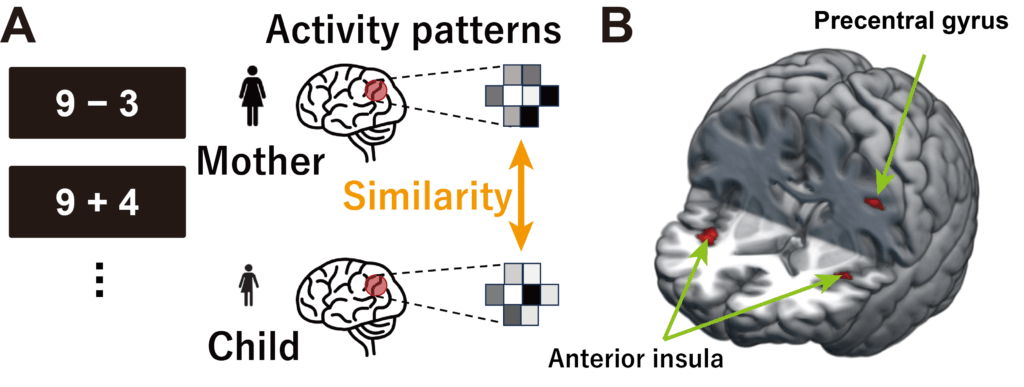[Press Release]Parents and Children Have Similar Brain “Math Circuits” – Discovery of Shared Brain Activity Patterns between Mothers and Children when Solving Math Problems
An international joint research team from France and Japan, including Tomoya Nakai (Chief Researcher) from Araya Inc., has for the first time revealed that brain activity patterns when tackling math problems are shared between mothers and their 8-year-old children. This discovery was made by measuring the brain activity of parent-child pairs using fMRI (functional magnetic resonance imaging). The study was published on August 12th in the American academic journal Proceedings of the National Academy of Sciences (PNAS).
- Key Points of the Study
- First-ever fMRI demonstration that brain activity patterns for solving math problems are strongly similar between mothers and children.
- Specific similarities unique to mother-child pairs were observed in brain regions involved in complex cognitive functions (anterior insula and precentral gyrus).
- The brain similarities correlate with the similarity in math abilities between mothers and children, suggesting a neural basis for the intergenerational transfer of skills.

- Study Overview
It is widely known from previous research in educational and developmental psychology that parents’ cognitive abilities significantly influence their children’s academic performance and development. Similarities between parents and children extend not only to physical appearance but also to personality, attitude, and learning strengths and weaknesses. It has also been reported that learning disabilities affecting reading, writing, and arithmetic tend to run in families. However, the neural mechanisms explaining these similarities in learning abilities were not yet fully understood.
Therefore, an international joint research team from the Lyon Neuroscience Research Center and Araya Inc. measured brain activity in 37 mother-child pairs (8-year-old children and their mothers) using fMRI while they performed single-digit addition and subtraction tasks and calculated the similarity of their brain activity patterns (Figure A).
The results showed similar generational brain activity patterns in multiple regions, including the parietal, frontal, and insular cortices, regardless of whether a parent-child relationship existed. This suggests that the human brain utilizes a somewhat common neural network for math processing across generations.
Furthermore, when the analysis was limited to the “mother-child” relationship, it was confirmed that the brain activity of parents and children was particularly similar in the left precentral gyrus and the bilateral anterior insular cortex (more so than in completely unrelated child-adult pairs) (Figure B). These regions are known to be involved in complex cognitive functions such as attentional control and working memory (the ability to temporarily hold information). This result suggests that the functional characteristics of the brain regions related to math may be inherited from parent to child.
Interestingly, this similarity in brain activity was also linked to the similarity in math abilities between mothers and children. This trend was particularly strong in mothers who struggled with math problems. These findings provide insight into how cognitive abilities are passed on at the brain level and are expected to be used for risk assessment of learning disabilities and the design of individually optimized educational support.
- Original Paper Information
Constant-Varlet, C., Nakai, T., Longo, L., Bouchet, H., & Prado, J. Familial transmission of neural representations for mental arithmetic across two generations. Proceedings of the National Academy of Sciences, 122 (33), e2421528122.
- Related Links
Published Paper
https://www.pnas.org/doi/10.1073/pnas.2421528122
Lyon Neuroscience Research Center
https://www.crnl.fr/en.
